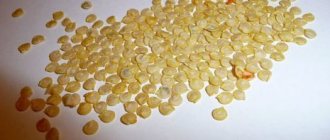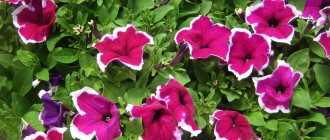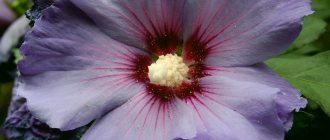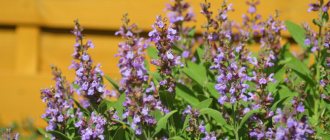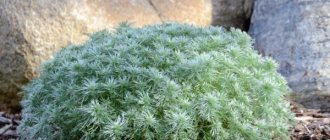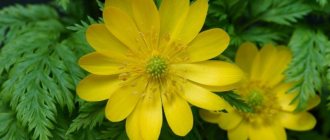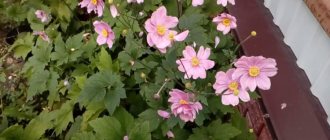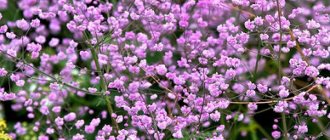- March 22, 2019
- Flowers
- Lyudmila Storozhenko
Among garden plants, hanging plants look especially impressive. They can decorate any garden plot. One of the most spectacular ampel-type plants is surfinia. Growing and caring for this plant is worth considering before cultivating it on your site. This will allow you to grow a beautiful plant that will delight the owners and guests of your garden plot with its flowering.
How the petunia variety Surfinia originated
Petunia Surfinia: photo
Scientist-breeders from Japan have created an unusual variety called Surfinia, or as it is also called Sulfinia. The Suntory company decided in the 70s of the 20th century to hybridize plant cells and adapt the large-flowered plant to poor climatic conditions. As a result, scientists created an ampelous type of petunia; propagation of this variety can only be carried out by cuttings in order to preserve the varietal characteristics. No seeds could be obtained from the plant. Petunia received the trade name Surfinia and received wide popularity and positive reviews among gardeners.
Beautiful in any weather
“What do I care about snow, what do I like heat, what do I like torrential rain” - these words are quite suitable for describing surfinia. The photo of the flower shows delicate gramophones, but they are quite resistant to various weather changes.
The plant's older relative, petunia, is not resistant to adverse weather changes. When there is a strong wind, the petunia petals are torn and they become pitiful. When it rains, the flowers turn into a homogeneous sticky mass.
Amateur flower growers are advised to hide pots, flowerpots and flowerpots with annual plants under the roof during bad weather. This is very inconvenient and troublesome; flowers can be damaged while moving. Unlike petunia, surfinia will show its best side both in rain and windy weather. They will remain neat and attractive. Sometimes you will have to remove water-damaged buds from the bush. But others will readily appear in their place.
The ideal ampelous flower amazes with its resistance to negative influences; the main thing is not to confuse it with other similar plants.
What ensures the beauty of the petunia variety
Petunia Surfinia: photo
The flower family has indescribable beauty. Different varieties have their own subtleties.
The variety is not considered simple. Petunia Surfinia flower petals have a diameter of about 9 cm, the color is bright and rich, and has a beautiful darkening in the middle. There may be a white border along the edges or, for example, the flower may have beautifully decorated veins. This is often characteristic of primary and standard varietal varieties.
Surfinia Double petunia flowers have thick and double petals, the colors are interesting and unusual. Varieties of Surfinia Mini are distinguished by small waterfalls of flowers with a diameter of no more than 6 cm, but the shades nevertheless remain saturated.
Surfinia ampelous - secrets of cultivation and the most popular varieties
Surfinia is a unique plant, one of the many hybrids of petunia, belonging to the ampelous group, although there are dwarf, very compact varieties. A distinctive feature of surfinia is the powerful growth of hanging stems and abundant flowering. Stems can reach up to 2 m in length. Flowers with a diameter of 2 to 6 cm have a wide variety of colors. Long hanging shoots strewn with large flowers look like a flower waterfall - this is ampelous Surfinia.
Distinctive features
Surfinia ampelous differs from petunia in the variety of shades of simple or semi-double flowers. In addition, this petunia hybrid is more resistant to many diseases and pests. Surfinia differs from classic petunia in having more abundant flowering. Caring for this flower plant is quite simple. In warm climates, flowering of surfinia can last several months. There are over 25 species of this unique petunia hybrid. In addition, there are many species that were obtained as a result of crossing.
Varieties
The most popular varieties of ampelous surfinia that flower growers grow on their plots are:
- Surfinia Burgundy is a massive and densely branching bush with abundant flowering. The flowers of this variety have a rich wine color.
- Surfinia Hot Pink is an attractive species with large bright pink flowers with pronounced crimson veins running from the throat to the wavy edge of the flower.
- Surfinia Table White is one of the most popular species. This favorite of many gardeners has snow-white bell-shaped flowers that densely cover the entire bush. The big advantage of this variety is the long flowering period - from May until the coldest weather.
- Surfinia Elou is one of the first ampelous petunia hybrids. This variety has early and abundant flowering of pale yellow flowers.
- Surfinia Double Purple is a double petunia with bright purple flowers. This variety is characterized by vigorous growth and resistance to excess moisture in the summer. Its hanging branches can reach 1 m in length, while the height of the bush is 15-20 cm.
- Surfinia Red is a very beautiful variety, forming a ball shape from many bright red flowers. This variety has a rather compact shape.
- Surfinia ampelous has many other species. Almost all of its varieties and hybrids are successfully grown in garden plots.
Reproduction of Surfinia
Most often, surfinia is grown using seeds. But the option of propagation using cuttings cannot be ruled out. A large cutting cut in the fall must be planted immediately or within 2 hours in fertile soil. Since the survival rate of the cut shoot decreases sharply over time. After planting in the ground, the cuttings should be covered with film or a transparent jar and placed in a warm place. Subsequent care consists of regular watering. As soon as a young leaf appears on the shoot, the shelter can be removed. The temperature of the seedling should not be lower than 20 degrees. Already in the spring, a full-fledged young bush will grow from the cuttings, which will delight you with abundant flowering.
Growing ampelous surfinia from seeds is a labor-intensive process and will require much more patience.
Seeds are planted in late winter/early spring. The soil used for planting seedlings is a mixture of sand with humus, turf and leaf soil. It is recommended to sift the surface layer of soil, approximately 1 cm, before planting the planting material. This improves the growing conditions of seedlings. 24 hours before sowing the seeds, the soil must be well moistened.
Since surfinia seeds are very small, they are mixed with sand before planting. You can also use seeds in a shell - this is how they are mainly sold. This will make the planting process much easier. Planting material is sown on the surface of the soil without falling asleep. After this, the soil needs to be moistened with a spray bottle and covered with film. During the week, crops should be kept in a shaded place at a temperature of 21-23 degrees. Subsequent care involves regularly spraying the seeds to keep the soil well moistened. When the soil dries out intensively, the spraying procedure is increased up to 2-3 times a day.
Within a week the first shoots should appear. Then the young plants begin to harden, periodically opening the shelter. It is worth remembering that ampelous surfinia petunia is a moisture-loving plant, so frequent moistening will only benefit it.
Seedling care
It includes regular fertilizing. Ideally, complex fertilizers with a high dose of potassium are suitable for surfinia. Surfinia needs to be fed throughout the entire period of growth and flowering. There should be a break of 2 weeks between each feeding.
After the first large leaf appears on the young sprouts, they are transplanted into separate pots. Surfinia petunia ampelous tolerates picking well. The main thing here is not to damage its delicate root system.
This flower loves sunlight very much, so its abundance is the key to full growth and abundant flowering of surfinia. The seedlings need to be placed in a well-lit place, and also illuminated with artificial lamps. During the daytime, you need to provide maximum lighting, but avoid direct sunlight. After 4-5 leaves appear on the seedlings, they are pinched, cutting off the apical shoot with 2-3 leaves. This procedure promotes the growth of lateral cuttings, which will allow the bush to grow into a lush and densely branched bush in the future.
If the young flowers are given proper and timely care, then already in May, powerful bushes with many shoots will grow from the small stems of surfinia, ready for planting in open ground.
Care during the flowering season
There is no need for haste in this matter.
Before planting seedlings in the ground, it is recommended to harden the plants. To do this, surfinia is taken out into the fresh air for several hours a day. As soon as the threat of the last frosts at night has passed, Surfinia petunia ampelous is planted in balcony boxes or hanging flowerpots. The grown seedlings are grown in the same soil that was used for sowing the seeds. To increase its moisture capacity and uniformity, you can add a small part of hydrogel or perlite. To create a lush bush, experienced gardeners recommend planting several surfinia bushes in one flowerpot at once. Growing flower seedlings in a container with side holes for seedlings will create a dense flowering ball.
Caring for surfinia includes three main rules: plenty of lighting, regular watering and timely feeding. Then ampelous petunia will delight you with abundant and bright flowering in the form of a cascade of delicate flowers.
LetovSadu.ru
Stages of plant development
Despite the beauty of the variety, you can notice that the Surfinia petunia variety is a very strong and resilient plant. If the flowers are in warm and fairly humid climatic conditions and are fed well and constantly, then in 60 days the plant can form long branches (up to 2 meters). Laterally, shoots form between the nodes, increasing their mass and forming into balls, pillows or waterfalls. The shape of the shrub depends on the planting technique that was used.
Important: A strong root system can support the plant in growth and flowering. In order for petunia to receive sufficient nutrition, you need to use no more than 6 liters of soil per plant. If the containers are small, then it is best to plant small-sized ampelous petunias.
How to grow surfinia at home: care tips
- Having purchased seedlings, do not rush to replant the plant in a pot: let it acclimatize to the new conditions. The adaptation period depends on the health of the seedlings, but no more than three weeks.
- The approximate volume of the container for two roots is about 8 liters. The larger the root ball, the longer the vine and the more inflorescences on it.
- It is better to buy soil in a specialized store and treat it with a weak solution of potassium permanganate. Glyocladin tablets, evenly buried over the surface, will help protect the roots from possible diseases.
- If it is not possible to purchase a ready-made substrate, mix garden soil, peat, and perlite in equal proportions. Acidity should not exceed pH 5.5 - pH 6.
- The drainage layer of large expanded clay covering the bottom of the pot is 3 cm.
- You will need a lot of light: without it, the petals lose their color saturation. But direct sunlight is strictly contraindicated. The ideal option for planting surfinia is a well-lit area in a south-west, south-east direction.
Important! Flowering ornamental plants are not replanted during flowering. This slows down the process of bud formation.
Resistance to negative climatic conditions
Most varieties of petunias struggle negatively with bad weather conditions. In windy weather, the petunia's petals almost open from the stem, and in rainy weather, the petunia loses its shape. When it rains, it is recommended to hide containers with plants under a canopy. But such a measure is not always practical or convenient.
The Surfinia variety does not suffer from bad weather; it does not need to be covered with anything. The only thing that can be done is to remove the leaves that have been damaged by the rain. The flower is able to grow new petals in a short time. Petunia will not lose its beautiful appearance from such a process.
The variety is classified as an ampelous variety, but it is very easy to confuse it with other varieties.
Diseases and pests
The new group of vegetative petunias is interesting not only for its decorative properties. In the description on the official website, the breeder-creators primarily mention its high adaptive qualities and immunity to common diseases characteristic of this genus. Problems appear only in two cases:
- the growing conditions recommended by the manufacturer are not met;
- the bush became infected from a nearby diseased plant.
The usual symptoms in these cases are dry or yellowed leaves, spots on the leaf blade, and dead buds. An examination to search for and find the parasite that is destroying your pet does not always give a positive result - the pests are so microscopically small. With the naked eye you can only see cobwebs - the result of the vital activity of various mites and sticky spots left by aphids. Therefore, in all doubtful cases, spray the crown with universal systemic preparations.
Petunia variety Surfinia: varietal characteristics
- Seedling material of ordinary petunia and varietal petunia have differences in the vigor of growth and the ability to form branches. Surfinia's planting material has larger dimensions. An ordinary plant has few shoots that stretch upward. The shoots of Surfinia resemble the formation of a spider; the branches first develop along the surface and then fall smoothly down.
- An adult plant of the same year forms a shrub in a variety of ways. To create splendor in an ampelous variety of flower, you need to pinch the side weavings, this will stimulate the branching of the plant. To begin with, greenery grows, and then it blooms. Such features are typical for ordinary petunias, but not for the Surfinia variety. Of course, the gardener can try to direct certain branches, but basically the plant is capable of forming a beautiful shrub on its own.
- Petunias also reproduce in different ways. An ordinary variety produces seed material, but if you grow a plant using them, the varietal characteristics are unlikely to be preserved. Reproduction using cuttings of Surfinia petunia is considered more effective. For the Surfinia variety, this is the only way to reproduce, since the plant does not produce seeds.
But ampelous petunia and varietal petunia are unlikely to differ in color, size and shape of flowers. For example, the Supertunia variety has no differences with Surfinia, they only have different originators.
Landing Features
Each plant requires a special approach. There are secrets and rules for planting seedlings. Unfortunately, it happens that after all the efforts, the plant actively blooms and grows, then abruptly stops its growth and begins to fade. To avoid this outcome, you should know some care features.
All varieties of surfinia have potential strength. For bushes to grow, you will need a large amount of soil and nutrition. If these two components are present in abundance, the plant will gain its growing volume and vigor. A 30 liter pot can accommodate 4 plants.
The surfinia flower will thrive in well-loose, fertile soil. When planting, it is better to use ready-made fertilizers; they nourish the plant longer.
The form of such fertilizers comes in the form of granules or capsules. Under the influence of moisture, they will gradually dissolve and nourish the roots of the plant. Throughout the season, the soil will be enriched with minerals and trace elements necessary for the flower.
For constant and dense flowering, fertilizers are not enough. In warmer climates, if there is a lack of moisture, hydrogels - water-retaining balls - should be added to the soil.
Varieties of petunia Surfinia
- Burgundy. The plant has an amazing wine-burgundy color. The shrub is large, actively branches, but at the same time the plant looks very neat, the branches diverge to the sides. The flowers are large, about 8 cm long. The plant is planted in pots, cache-pots, and also in flower beds. Petunia can be allowed to grow vertically, which will look very original and beautiful.
- Velvet Blue. Quite an interesting and bright variety of ampelous petunia. The flowers are not very large, the petals are velvety to the touch with a slight wave. There are a lot of inflorescences on the bush. The size of the pharynx is miniature, has a light shade, the flowers look as if they are completely purple.
- Hot Pink. Medium-sized variety with large beautiful inflorescences. The flowers are deep pink in color and have a burgundy throat inside. The veins of the petals are crimson in color, this gives volume and weight to the shrub. Looks beautiful in hanging flowerpots.
- Deep Ed. The variety often participated in many flower exhibitions and received great recognition and the title of laureate. The color of the plant is bright and deep red, which can be found in these flowers. Plants are not propagated by seeds, as varietal characteristics are lost; cuttings of Surfinia petunia are mainly used.
- Tumbelina Suzanne. It is closely related to Surfinia, but is classified as a Tumbelina variety. You cannot immediately tell from the plant that it is a petunia. The flowers are large in size and have a delicate cream color. The variety is difficult to find; the plant can be propagated by cuttings. The variety is classified as rare.
- White. The plant develops quickly and actively. The lashes stretch 1.5 meters, there are many flowers, located close to each other. Petunia is often planted in a cascading flower bed. The flowers are medium-sized, snow-white in color, the throat has a yellowish tint.
- Giant Purple. Petunia is strong and robust. The flowers are up to 10 cm in diameter. The throat has a rich black tint, the petals themselves are a dark crimson hue. The flower looks original and beautiful.
- Green Edge Pink. The flowers of the plant have an unusual color: the petals look like corrugated pink paper, the edges of the flowers are light green. The bush is dense, develops well, neat and miniature. The foliage is hardly noticeable because of the flowers. To form a bush, you do not need to pinch it.
Surfinia flower: main characteristics of the plant
The Surfinia flower is a hybrid of everyone's favorite petunia. For more than two decades, it has occupied a leading place in floriculture among hanging plants, which are designed to give beauty on terraces, recreation areas, and decorate public gardens and gardens. If, walking past a terrace, you see a pot with a luxurious head of bright flowers, emitting a pleasant light aroma - this is most likely surfinia.
The long shoots of the plant are abundantly decorated along the entire length with a cascade of bright, varied buds.
The flowering period lasts from the beginning of summer until the first severe cold weather. Flowers in the form of small gramophones can be of different colors - from snow-white to dark burgundy.
Many novice flower growers wonder what the difference is between Surfinia and Petunia. To answer this question, we can say that the hybrid has surpassed its mother plant. Despite the fact that surfinia is one of the varieties of petunia, it has a higher growth rate, allowing it to form an adult, spreading bush within a few months after planting. The flowering period is much longer than that of petunia, and it is also endowed with high resistance to diseases, pests, and weather conditions.
How to plant petunia seedlings Surfinia
This variety itself is strong and capable of growing quickly and actively, so the plant must be regularly fed with special preparations and planted in good fertile soil. If the amount of soil in the pot is large, then the roots of the petunia will be strong, thereby the seedling will be large and powerful in size and characteristics.
When planting Surfinia petunia seeds in a pot or cache-pot, they must contain at least 5 liters of soil. More than 4 seedlings cannot be planted in a thirty-liter container.
The soil used is loose, light and most importantly fertile. High-quality fertilizer materials are used as fertilizer, which are capable of affecting petunia for a long period of time. Most often, the store assortment includes granules and capsules, which, when combined with liquid, saturate the soil with useful microelements. But in order for the plant to bloom for a long time and delight with its appearance, it is necessary to use not only such fertilizing materials. In the hot summer season, you need to add hydrogel balls to the soil, which retain liquid well.
Watering and lighting
The process of growing surfinia from seeds at home is relatively simple. After planting in the ground, it is necessary to provide sufficient lighting for the plant. Proper watering is also important. If the seedlings do not receive enough light, they will weaken. The shoots will not form many buds.
For Surfinia to feel good, it needs to receive light for at least 10 hours. Therefore, quite often the plant does not have enough natural light. It will be necessary to create artificial lighting in the evening.
In order for the plant to develop properly, it is necessary to provide abundant watering of surfinia. Cultivation and care require certain attention from the gardener. Surfinia requires regular and abundant watering. At the same time, the crop is quite resistant to drought. During the summer months, the root system grows greatly. It requires sufficient moisture.
Surfinia should be watered frequently if the weather is dry and hot. On such days, you need to irrigate the soil twice a day. However, overmoistening should not be allowed. Otherwise, the roots will rot. This can lead to the death of surfinia.
Petunia Surfinia: fertilizers and fertilizing
Ampelous petunia Surfinia loves regular feeding, so this part of the care is considered the main one.
Liquid fertilizers, which are made by combining water and organic matter or minerals, bring greater results. Such feeding is carried out once a week.
After planting, the plant can be fertilized with nitrogenous fertilizers, or even organic matter can be used. Nitrogen helps the plant actively grow shoots and petunias begin to branch. To form a strong and strong root system, you need to use fertilizers with phosphorus.
From the moment the inflorescences form until the end of flowering, the plant is fertilized with potassium-phosphorus complexes. The most effective are: Kristalon, Plantofol, Kemira Lux and others.
In order for flowers to grow quickly and intensively, you can resort to the use of growth stimulating agents, for example, Zircon or Epin.
If the plant is planted in open fertile soil, then it does not need to be fed so often. This needs to be done approximately 4 times per season. But the quantity becomes more clear based on the appearance of the petunia.
How to achieve lush flowering?
Properly selected fertilizers are secret number 1. Starting in February, the flower is fed with nitrogen-phosphorus-potassium compounds once a month. Liquid and powdery concentrated products show good results:
- AgroMaster – Russia;
- ASB Greenworld (Greenworld) – Germany;
- Agricola-Aqua – Russia;
- PLANTON®S (200g) – Poland.
Air temperature within the range of +18° to +25° is secret number 2.
And the third secret is the duration of daylight (without direct sunlight) from 6 to 8 hours.
Ampelous petunia Surfinia: Formation of a bush
Surfinia petunia varieties rarely need to be shaped. But if the bush has poor branching, you need to pinch out 20-30 centimeter shoots, after which the bush will be more fluffy.
When flowering, wilted flowers are removed. This improves the appearance of the plant and petunia does not devote excess energy to seed formation.
If you have good plants, you can apply it to cuttings of Surfinia petunia in winter or spring. Petunia takes root well, and next season you can get a beautiful and beautiful plant.
Propagation of Surfinia by cuttings
- Cut off young, healthy, non-lignified shoots with tops. Remove the lower leaves and buds.
- Place the cuttings in an aqueous solution of a root formation stimulator.
- After a day, transfer to a container with settled water.
- After the roots appear, plant in a container with the prepared substrate: peat, sphagnum moss, vermiculite, turf soil in a ratio of 1:1:1:1.
- To create a comfortable microclimate, cover the mini-greenhouse with glass or cling film.
- Open the pallet for 10 minutes every day to ventilate.
- You can replant the rooted stem into a flower pot after 3 weeks.
- Further care comes down to regular watering and fertilizing.
Video
We offer useful information about the main differences between petunias and surfinias, as well as the features of propagation and care of these plants in the following videos:
His main specialty is an accountant, so even at his dacha he strives for accuracy and achieving ideal order in everything. Preference is given to growing grapes. I am sure that the deeper you delve into gardening and gardening, the more you understand that there is no limit to perfection!
Found a mistake? Select the text with the mouse and click:
From varietal tomatoes you can get “your own” seeds for sowing next year (if you really like the variety). But it is useless to do this with hybrids: you will get seeds, but they will carry the hereditary material not of the plant from which they were taken, but of its numerous “ancestors”.
In little Denmark, any piece of land is a very expensive pleasure. Therefore, local gardeners have adapted to growing fresh vegetables in buckets, large bags, and foam boxes filled with a special earthen mixture. Such agrotechnical methods make it possible to obtain a harvest even at home.
The homeland of pepper is America, but the main breeding work on developing sweet varieties was carried out, in particular, by Ferenc Horvath (Hungary) in the 20s. XX century in Europe, mainly in the Balkans. Pepper came to Russia from Bulgaria, which is why it received its usual name - “Bulgarian”.
Natural toxins are found in many plants; Those grown in gardens and vegetable gardens are no exception. Thus, the seeds of apples, apricots, and peaches contain hydrocyanic acid, and the tops and peels of unripe nightshades (potatoes, eggplants, tomatoes) contain solanine. But do not be afraid: their number is too small.
You need to collect medicinal flowers and inflorescences at the very beginning of the flowering period, when the content of nutrients in them is highest. Flowers are supposed to be picked by hand, tearing off the rough stalks. Dry the collected flowers and herbs, scattered in a thin layer, in a cool room at natural temperature without access to direct sunlight.
“Frost-resistant” varieties of garden strawberries (more often simply “strawberries”) need shelter just as much as ordinary varieties (especially in those regions where there are snowless winters or frosts alternating with thaws). All strawberries have superficial roots. This means that without shelter they freeze to death. Sellers’ assurances that strawberries are “frost-resistant,” “winter-hardy,” “tolerates frosts down to −35 ℃,” etc. are deception. Gardeners must remember that no one has yet managed to change the root system of strawberries.
Convenient Android applications have been developed to help gardeners and gardeners. First of all, these are sowing (lunar, flower, etc.) calendars, thematic magazines, and collections of useful tips. With their help, you can choose a day favorable for planting each type of plant, determine the timing of their ripening and harvest on time.
It is believed that some vegetables and fruits (cucumbers, stem celery, all varieties of cabbage, peppers, apples) have “negative calorie content,” that is, more calories are consumed during digestion than they contain. In fact, only 10-20% of the calories received from food are consumed in the digestive process.
Compost is rotted organic remains of various origins. How to do it? They put everything in a heap, hole or large box: kitchen scraps, tops of garden crops, weeds cut before flowering, thin twigs. All this is layered with phosphate rock, sometimes straw, earth or peat. (Some summer residents add special composting accelerators.) Cover with film. During the process of overheating, the pile is periodically turned or pierced to bring in fresh air. Typically, compost “ripens” for 2 years, but with modern additives it can be ready in one summer season.
The most common varieties of Surfinha
The breeding company Suntory (Japan) offers a wide selection of Surfinia series and varieties. Some of the most spectacular are:
- Double series. These are large double flowers. They are often used in decorating balconies, gazebos, and houses. The bushes do not bloom profusely, which emphasizes their uniqueness (Surfinia Double White, Double Purple, Double Red). Surfinia Parple is one of the most popular among summer residents.
- Specials Series. It includes new developments endowed with many qualitative and advantageous characteristics (color, shape, parameters). Specials series varieties – Surfinia Amethyst, Picotee Blue, Green Edge Pink.
- Series Table. The special feature of the series is the abundantly blooming flowers. The bush becomes very lush. Basically, these are compact, ampelous and semi-ampeloid petunias. All flowers resemble bells in shape. Varieties – Surfinia Table Yellow, Table Pink Morn, Table Dark Red, Table SalmonVein.
- Classic Series. The varieties of this series have traditional forms for petunias. Basically, classic varieties are early flowering. The stems of the bushes are powerful, distinguished by long shoots on which many flowers grow. Classic varieties - Surfinia White, Red, Deep Red, Blue, Blue Vein, Velvet Blue, Yellow, Burgundy, Sweet Pink, Hot Pink.
One of the latest innovations from the Japanese company is the Surfinia GreenEdgePink variety. Characterized by pink flowers with soft green edges.
Wintering and rest period
Over the course of a season, the plant becomes depleted and weakens. The mother flower is stored in cool rooms: underground, basement, equipped nurseries at a temperature not lower than 6-7 °C.
Preparing for winter
Before transferring to wintering, the plant is pruned, withered leaves and lashes are removed. Treated against diseases and pests with Redomil Gold with the addition of Teplike (insecticide).
During the dormant period, the plant “falls asleep.” All life processes slow down: nutrition absorption, root work. Water the plant occasionally (no more than once a week) so that the roots do not dry out and die.
In nurseries, when it’s frosty, the flowers are covered with spandbond and the room is heated. If there is no cool place, surfinia can overwinter in a room at temperatures up to 20 °C. The shoots will continue to grow, but slowly, they will be weak and thin.
Note! Any place where surfinia overwinters should be illuminated, but not as much as during the period of vegetative growth.
By spring, flowers wake up: foliage grows, buds form. The plant can be cut from cuttings.
Tender does not mean weak
The appearance of a flower is deceiving. As graceful and gentle as he is, he is also strong. In favorable conditions with plenty of heat and moisture, the surfinia flower grows in 2 months so that sometimes two-meter stems take up a lot of space in the garden. Knowledgeable people plant plants higher or further away from each other.
Side shoots on the stems grow from each internode, and the more of them, the thicker the plant’s cap and the richer the abundance of flowers. Thus, the vegetation mass increases. It comes in different forms:
It all depends on the gardener’s imagination and planting method.
Surfinia boasts not only the beauty and abundance of shoots, but its root system can only be envied. It is very strong and branchy. For normal growth and nutrition, one seedling will require at least 5 or even 7 liters of soil.
Where to buy Surfinia?
Most often, surfinia is bought in garden stores or at flower shows in the form of ready-made seedlings. Grown-up seedlings tolerate replanting well, take root well and quickly increase green mass.
The seed method of propagating surfinia is practically not used, since the plant sets few seeds, and even those have low germination. When purchasing seeds, you should pay attention to their shelf life. It is important to know that coated specimens have a shorter shelf life compared to regular ones.
According to reviews from flower growers who grow surfinia, the plant easily takes root in a new place and requires a minimum of attention.

